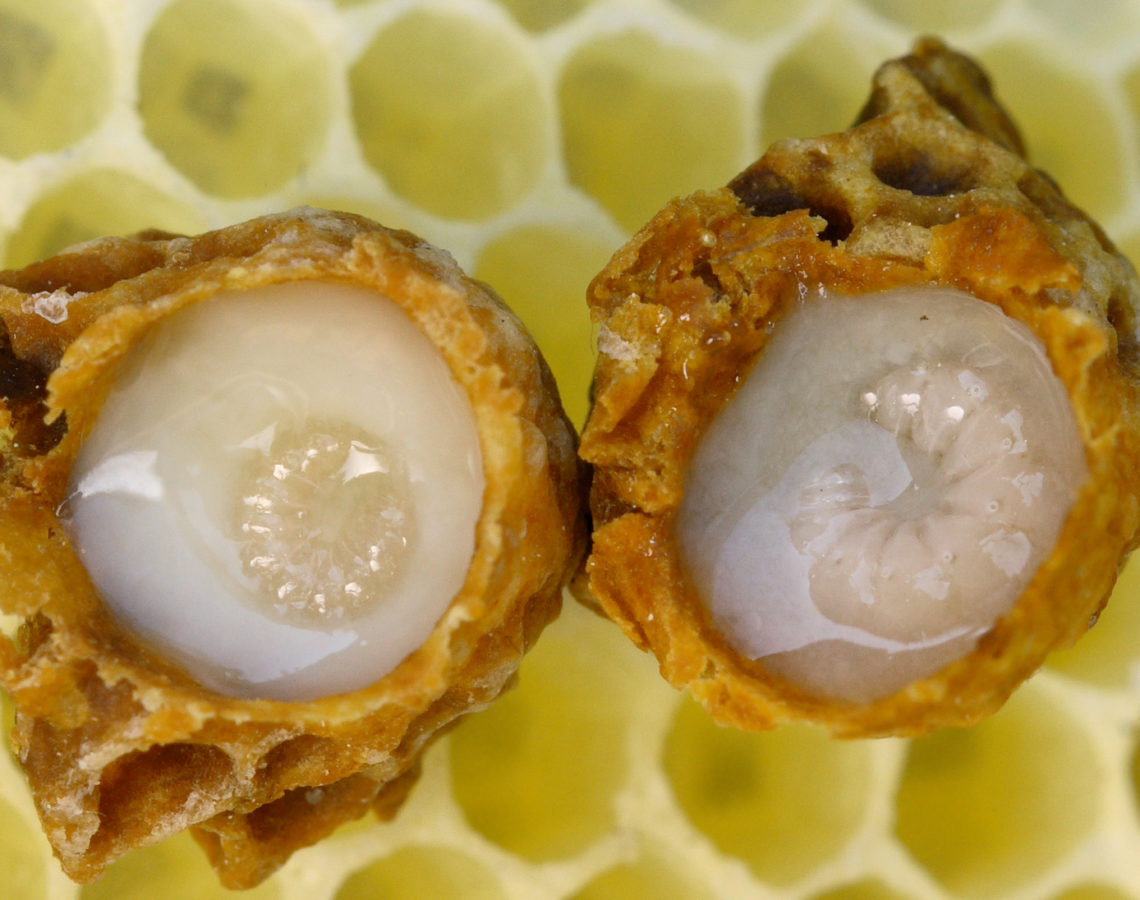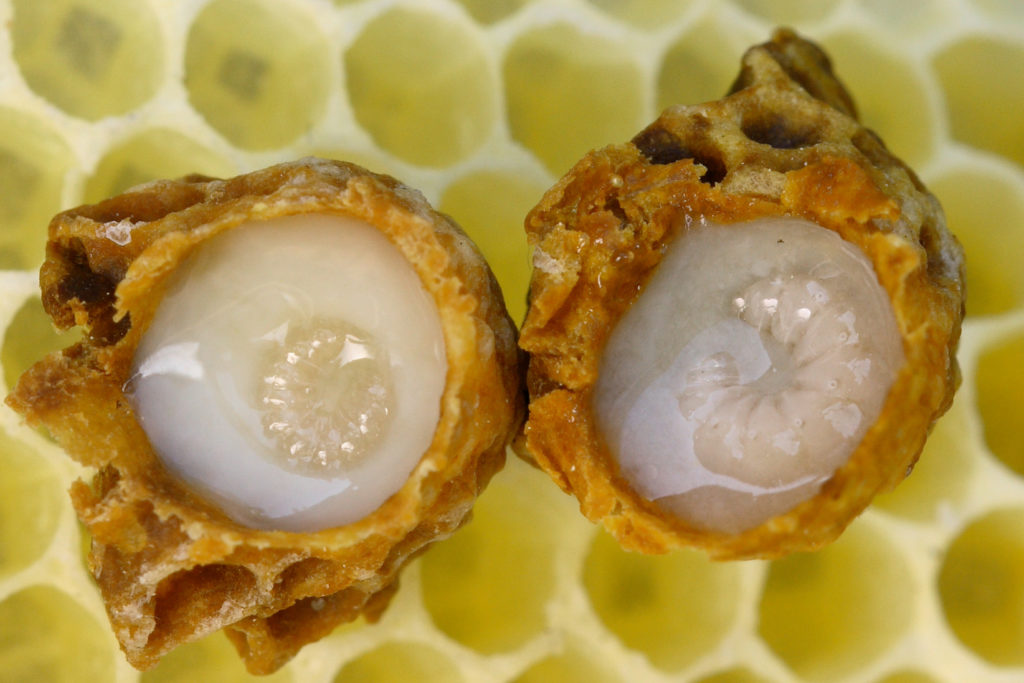Is Royal Jelly Really the Secret Fountain of Youth?

A few weeks ago I asked Evie, a Two Hives team member, the top 10 questions she receives through our website. One of these questions was folks asking if we sell royal jelly. We don’t, and I thought I would spend this month explaining what royal jelly is and why we choose not to harvest it.
Royal jelly is a milky white substance made of about 60% water. The rest of the royal jelly is mostly proteins and sugar, with a small amount of lipids and minerals. Royal jelly is produced by young adult bees, ages 7-10 days. These young bees have glands on the side of their heads called hypopharyngeal glands. (Say that three times fast!) These glands are underdeveloped at hatching, and only the consumption of pollen allows for their full development. It is here in these glands that royal jelly is produced. These bees must be fed a diet that includes protein in the form of pollen to produce royal jelly.
Royal jelly is an important part of brood (baby) rearing. Royal jelly is fed to newly hatched drone and worker bee larvae and queen bees. Drone and worker bee larvae consume this royal jelly exclusively for the first 3 days after hatching. Unlike pollen and nectar, royal jelly cannot be stored, so it is fed to the larvae directly into the cell by the young nurse bees. What results is the larvae swimming around in this food. After three days the workers and drones are switched to a diet of pollen and nectar. However, queen bee larvae and adult queens exist solely on this royal jelly diet.
So what’s so special about this royal jelly? The fascinating part of early honey bee nutrition is that a female worker bee’s diet will determine her caste and role in the hive! There is no such thing as a queen bee egg. Queen bees develop from worker bee eggs. Remember that each hive has only one queen, whose singular job is to lay eggs. On the other hand, a hive will have tens of thousands of worker bees, who literally perform every other function in the hive, from heating and cooling, collecting food, and taking care of the young. But they all develop from the same worker bee eggs. The only difference here is that if a hive wants to make a new queen bee, they feed a newly hatched worker bee larvae royal jelly exclusively, while a would-be worker bee is fed a little royal jelly for three days, then she is weaned over to a diet of pollen and nectar.

Workers are sterile, smaller with stingers, and have short life spans of 6-8 weeks. Queens can mate and therefore are fertile, are larger in size, do not have stingers, and can live several years. Given the biological differences that result from this very small diet change it’s no surprise that royal jelly is seen as a sort of magical substance. (Though it’s worth noting that recent research suggests it’s not the presence of the royal jelly that makes a queen bee, but perhaps the absence of the pollen that makes a queen!)
Royal jelly has been purported to provide a myriad of different health benefits, from boosting stamina and lowering cholesterol, to promoting youthful skin and boosting immunity. Research has found that royal jelly has antibacterial and antioxidant properties. However, very few studies have been performed on humans and I’ve found no definitive research supporting some of the bolder claims that royal jelly can help cure diseases like cancer or diabetes. You can find royal jelly in dried capsule form, skincare lines, and even shampoo.
Royal jelly isn’t cheap: it’s a painstaking process to produce and it’s difficult to produce royal jelly in large amounts easily. So how do beekeepers harvest royal jelly? Beekeepers will create a colony of honey bees with no queen. Understanding that a queenless hive will take great pains to create queen bees, the beekeeper will provide the queen-less colony with small cups with a worker bee egg inside each cup. Once the worker bee hatches, the colony will work to create queen bees by flooding the larva’s cell with royal jelly. The beekeeper will then suck the royal jelly out of the cell, essentially starving the queen larvae in the process.
I personally don’t consider the practice ethical or humane. I’m not a vegan–but I do my best to ensure that the animal products I consume and use were produced in a humane manner. I think there is also a cost benefit analysis necessary in these situations: if we knew for sure that royal jelly cured cancer, I would most certainly be supportive of the practice in the absence of other alternatives. But if we are simply rearing queen bees to be killed because we want to reduce face wrinkles, I think we need to reexamine our priorities.
What do you think? Have you used royal jelly and seen any benefits? Do you think the benefits outweigh the concerns with harvesting? Comment below and let me know your thoughts!



Please be so kind and include me in your mailing list. The articles are very interesting. I am from South Africa 🇿🇦
Thank you, Drienie. You have been added to our mailing list.
I loved your explanation of royal jelly. I was never sure what it was, just knew it came from bees. I don’t like the idea of starving the ‘never going to be’ queen bees just to make vanity products. All creatures except mosquitoes have a task to do, a function to keep the world balanced. Just joking about mosquitoes. I’m happy your company will not harvest royal jelly!.
Glad you enjoyed the article, Karen. We feel bees should always come first, it’s our main core value!